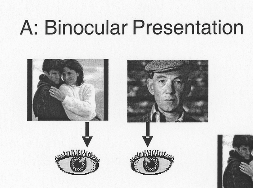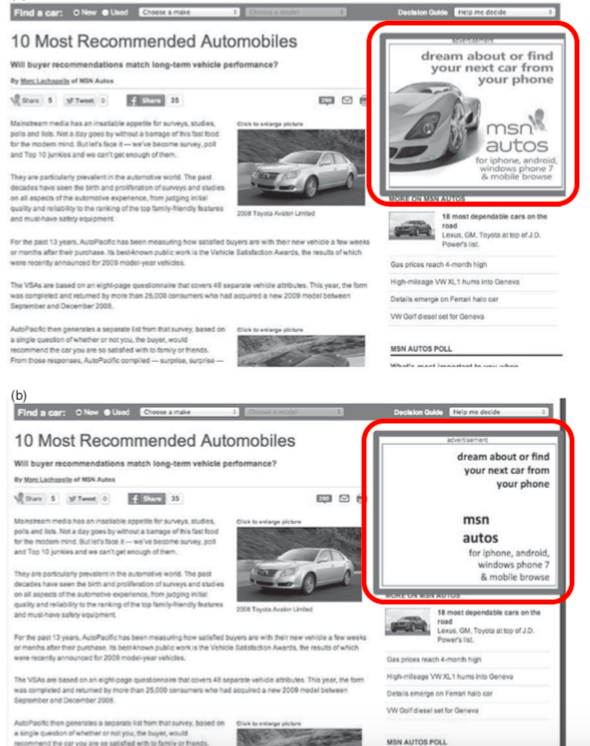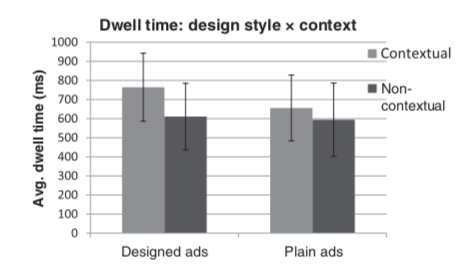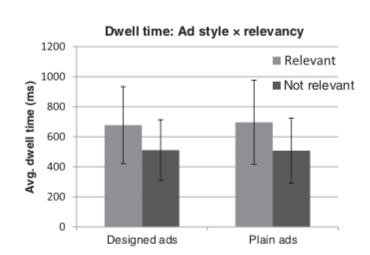I. What Makes People More Likely to Notice Ads?
One way for ads to grab attention is to use emotionally charged content. This can be conscious, like those unfairly sad Thai life insurance commercials (warning: you will probably cry if you click this link). One inventive study demonstrated the effects of emotional content by showing different images to each eye at the same time. One image was neutral (e.g., a person looking at the camera with no expression) and one was emotionally charged (e.g., two people smiling and touching each other). Example:

The researchers looked at which picture was perceived first by users’ visual systems and found that the emotionally charged pictures were actually processed first.
The authors of this study — Resnick and Albert — had previously found that users in studies were more likely to ignore banner advertisements if they were assigned tasks to complete on a website rather than simply browsing.
(Although the authors diligently note that another study by a different researcher had found that users trying to complete tasks and users “free browsing” were roughly equally likely to notice banner ads.)
Resnick & Albert wanted to see if they could catch users’ attention by varying the content or look of the advertisements in a non-intrusive way. For example, when using a search engine, users (not surprisingly) are more likely to pay attention to ads that matched the content they searched for. But people also report feeling suspicious and uncomfortable when ads are perceived as overly targeted. So personalized advertising has to walk a bit of a tightrope.
II. The Studies
Study 1
The first study looked at 30 users who were browsing in order to complete tasks. Half the users were shown banner ads that were relevant to the page (eg, an ad for running shoes on a jogging website), and half were shown irrelevant ads (eg, ads for toilet seats on a jogging website).
Resnick & Albert also showed ads to some users that had the styling and colors removed, making the ads much more plain. An example is below. While the screenshots below are black and white, you can see that the car advertisement in the top image has been modified to have its color and design elements removed.

When the researchers looked at the designed ads and the plain ads and the relevant and irrelevant ads, they found no significant differences between the any of them (although some of the results seemed to be trending towards significance). The graph of results looks like this:

We can see that non-contextual ads seem to be less effective, but the effect isn’t significant yet (indicated by the overlapping error bars on the top of each bar). Contextual designed ads also seem like they might be a little more effective than contextual plain ads, but the difference isn’t statistically significant and the sample size is small enough that this could easily be coincidence.
Study 2
The researchers realized that they might need more relevant ads to catch users’ attention. Even if the ads were relevant to the page, they might not be relevant to the users’ tasks. So Resnick and Albert conducted a second study, this time with 50 users.
Again, users were given a task (“Learn about how to replace car parts,” for example) and shown a website. This time, users did dwell longer on task-relevant ads than irrelevant ads, and the effect was statistically significant. Interestingly, the difference between designed ads and plain ads is quite obviously zero.

III. Takeaways
1. Designed Ads and Plain Ads Are Roughly Equally Effective At Drawing Attention
Neither study shows a large difference between how much attention users paid to designed ads vs. plain ads. Considering the amount of money spent on internet advertising — a significant amount of which goes presumably goes towards these aesthetics flourishes — these findings are fascinating.
It’s still possible that brands are more likely to be judged as high-quality if their ads are carefully designed rather than just plain text. But if it turns out that plain-text ads are just as effective as highly designed ads, then ad firms might be able to save themselves some money on future campaigns.
2. Targeting Websites is Probably Less Effective than Targeting Tasks
The effects might not be significant, but I’m not comfortable looking at the graph in Study 1 and concluding that website-relevant ads are no more effective than website-irrelevant ads. But the results in Study 2 are significant, which implies that task-relevant ads are the most effective kind of ad targeting.
UX Takeaways
It might not be totally responsible to extrapolate these results beyond banner advertisements. This paper doesn’t even examine all the facets of banner advertisement effectiveness. It’s possible, for example, that people look at plain ads and designed ads for equal lengths of time but are more persuaded by designed ads.
But this paper at the least suggests interesting avenues for future research. I’ve seen multiple products progress from idea to completion, and a regular point of debate is how much effort should go into aesthetics vs functionality at each stage. Many of these discussions take it as a given that aesthetics are valuable, and people regular cite popular wisdom about the importance of first impressions and the strength of our intuitive subjective judgements. These results suggest that that there might be some cases — like perhaps trying to complete a task while in a stimulus-heavy environment like the internet – functionality is far more important than design.